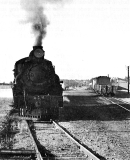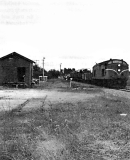Ohinemuri Regional History Journal 44, September 2000
TIROHIA - AN INTERESTING RAILWAY STATION
J.A.T. TERRY.
Public Works Department documents on the construction of the railway line to Paeroa do not appear to have survived but railway records indicate that the department planned a station at Tirohia. It was to be called Okahukura, the name of the native Village situated about two miles lower down the Waihou River.
When the line to Paeroa was opened on 20 December 1895 there was no station. On 16 June 1899 the District Traffic Manager (DTM) at Auckland suggested to the General Manager that a passenger platform be erected at about the 39 mile peg near where the Paeroa to Waihou road, then under construction, would cross the line. An earth platform without a shelter shed or siding accommodation would meet the requirements, the name of the station was to be Te Rae-o-te Papa. Approval was given on 16 September 1899, the station to be called Tirohia. While the District Engineer at Auckland (DE) considered the name may be confusing with Te Aroha and suggested the original intention of the Public Works department to call it Okahukura would be better, Tirohia was confirmed.
On 13 October 1899 a special train ran material to the new site, the station being opened for passenger traffic only on 1 November 1899. It was situated at 4 miles 22 chains from Paeroa and 39 miles 7 chains from Frankton. It was on the left-hand (north) side of the track and a name board "Tirohia" supported on posts indicated the station.
In November 1902, at a cost of £17.12. 7, a shelter shed was provided.

In the summer of 1954 a Frankton bound goods train shunts the petrol and goods shed siding. The small station building can be seen on the right of the train. On the far right the original siding laid for the Quarry Company.
Tirohia Railway Station
Ohinemuri Regional History Journal 44, September 2000
December 1904 saw a request from the settlers in the vicinity for the station building to be shifted to near Cadman Road, about two miles closer to Paeroa, and a public siding provided. The request was declined. Subsequent requests for a public siding were made in 1905, 1908 and 1909. When commenting on the 1909 request, the Inspector of Permanent Way at Te Aroha suggested that the best place for a siding would be at the Cadman Road crossing (40m 75c). The DE saw no reason to warrant the removal of the station.
In 1912 the Tirohia Quarry Company started operations at Tirohia and in June approached the railways concerning the laying of a private siding giving access to their 2ft 10inch-gauge tramway. Horse drawn trucks would cart metal from the quarry to be discharged from a loading bank into rail wagons. By 14 October the siding was ready for use. Holding 30 wagons, it had cost the company £384 plus the cost of the loading bank which it had to erect. There was a yearly rental of £1 for the right to lay a tramline on railway property and £25 for the siding right. In November 1913 the settlers tried again to get the station moved to Cadman Road. The DTM did not consider the traffic warranted a station there and as Tirohia station was used daily by workers employed at the quarry it would not be advisable to shift it.
On 20 February 1917 the shelter shed was blown off its blocks and carried about 11 yards. It was repaired and replaced on its blocks. March 1919 saw a further siding request and this time stockyards were included. Writing to the DE the DTM mentioned that previous requests had been declined on the grounds that as the Waihou was unbridged the traffic would not be sufficient to warrant a public siding. However the erection of that bridge had altered the position and any improvements should include a public loading loop for 12 wagons, a 30' x 20' goods shed, loading bank and livestock pens with a six wagon capacity. Room should also be provided for a future crossing loop of 40 wagons minimum. The provision of cattle loading facilities would obviate the necessity of settlers driving stock to Waihou. Clearly the DTM saw a bright future for the station and while the DE agreed nothing was done.
Early in 1926 a further request was received. A plan was prepared which made provision for a loop siding and loading bank and in the future for a goods shed and small stockyard. It involved the shifting of the platform and shelter shed to the southern side of the line. On account of the increased passenger traffic there would be a privy and urinal. The latter had become a necessity. In November 1924 the Ticket Inspector had complained on the not too particular habits of some passengers alighting at the station. He had suggested that the shelter shed be used as a ladies waiting room and the erection of toilets for males. The cost of the work would be £1,500. The General Manager approved. When the work was completed in November 1926 there was a new siding holding 32 wagons, a loading bank, privy and urinal. Not until July 1930 was a goods shed provided and then it was not to be a standard 30' x 20' one but a 20' x 1 2' shed which had stood at the south end of the Pukekohe station platform and had been used as a store room, dismantled and re-erected at a cost of £62. 6.10. No verandah was provided and Tirohia was never to get a stock yard or ladies waiting room.
I do not know when the quarry tramway ceased to operate, but by 1951 it had been removed. In 1955 the quarry was supplying ballast to the railway and Railways intended to stockpile it in the station yard. This would mean building a new loading bank, removing the old one and resiting the shelter shed, platform, privy and urinal. However as passenger traffic was not considered sufficient to warrant retention of the passenger facilities, the station was closed to passenger traffic and those facilities removed. In March 1956 a new siding holding 83 wagons and a new loading bank were ready for use. In May 1975 the public siding was removed and in December 1977 the goods shed sold for removal. On 27 April 1980 Tirohia was closed to public traffic but the siding was retained for ballast loading.
When the line from Waitoa to Thames was closed on 29 March 1995 it had not been used for some time and all that remained at Tirohia was the overgrown main and ballast lines. In Journal No 38 (September 1994) Mr I Parlane referred to the delivery of bulk petroleum products by barge to Tirohia. From 1942 until 1968 the station was to be involved with the distribution of motor spirit. In August 1941 the Associated Motorists Petrol Coy. Ltd (later to be known as Europa), advised of its intention to transport oil fuels by barge from Auckland up the Waihou River to Tirohia where a site had been acquired on the south side of the railway line for a bulk storage depot. Fuel would be pumped from the barge and piped under the railway line to the depot. From 1 March 1942 a right for the pipe to run under the line was granted to the company at a cost of 10/- per annum. It is not known why transport by barge ceased but it may have been cheaper to transport by rail as there was a special local rate between Auckland and Paeroa for rail tanks of motor spirit. In September 1942 the Company was exploring the possibility of a private rail siding at Tirohia it having recently withdrawn from Hastings where it had a private siding and wished to use the recovered material. However as it was neither sufficient nor suitable for a siding at Tirohia the proposal was dropped in favour of using the railway siding. A standpipe was provided by which petrol could be pumped from railway wagons to the bulk depot. From the 15 November 1942 this method was used. The right to erect a stand pipe and lay a new pipe under the line cost £1 per annum and the right to use the railway siding £25. In August 1952, to assist pumping, an electric motor was installed.
In June 1955 the Company (then Europa) enquired as to the cost of laying a private siding but at £2100 it must have deterred it for nothing further was heard on the matter. As from 28 February 1968 the Company cancelled the grants, although the pipe and pipe stand were not removed until 5/6 October 1968.
Throughout its life Tirohia was to remain an unattended flag station.
References: District Engineer NZR Hamilton Tirohia Files: 241/1 Station Building, 241/2 Sidings, 241/4 Stock Yards, 241/7 Goods shed. Closed files 69/11 Rail siding Europa Oil and 103/47 Tirohia Quarry private siding.



